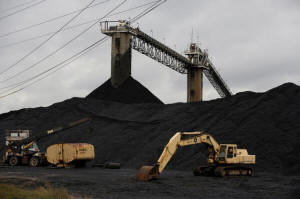|
A year after Trump's election, coal's
future remains bleak
 Send a link to a friend
Send a link to a friend
 [November 13, 2017]
By Timothy Gardner [November 13, 2017]
By Timothy Gardner
WASHINGTON (Reuters) - A year after Donald
Trump was elected president on a promise to revive the ailing U.S. coal
industry, the sector’s long-term prospects for growth and hiring remain
as bleak as ever.
A Reuters review of mining data shows an industry that has seen only
modest gains in jobs and production this year - much of it from a
temporary uptick in foreign demand for U.S. coal rather than
presidential policy changes.
U.S. utilities are shutting coal-fired power plants at a rapid pace and
shifting to cheap natural gas, along with wind and solar power. And
domestic demand makes up about 90 percent of the market for U.S. coal.
"We're not planning to build any additional coal facilities," said
Melissa McHenry, a spokeswoman for American Electric Power, one of the
largest U.S. utilities. “The future for coal is dictated by economics …
and you can’t make those kinds of investments based on one
administration’s politics."
Coal plants now make up 47 percent of AEP’s capacity for power
generation, a figure it plans to shrink to 33 percent by 2030.
(For a graphic on coal production, demand and employment, see:
http://tmsnrt.rs/2zKY1tQ)

The situation highlights the limitations of presidential policy on major
industries and global economic trends. As some energy experts have said
all along, the forces that will make or break mining are well beyond the
powers of the Oval Office.
A White House official did not respond to a request for comment.
Trump has likely done all he can do to help the industry, said Luke
Popovich, a spokesman for the National Mining Association, which
represents major U.S. coal companies.
“The government is no longer against us," he said. "We now only have
market forces to contend with.”
Trump has taken action on many promises he made to coal interests in
states that helped him win the election.
The president started the process of killing former President Barack
Obama’s Clean Power Plan, meant to reduce carbon emissions from power
plants; ended an Obama-era moratorium on coal leasing on federal lands;
ditched limits on dumping coal waste into streams; and started
withdrawing the United States from the Paris Climate Agreement.
Now Trump’s Energy Secretary, Rick Perry, is attempting to push a rule
through the independent Federal Energy Regulatory Commission that would
subsidize power plants that store at least a 90-day supply of coal on
site. The goal is to extend the life of some coal burning power plants,
a move Perry says will make the electric grid more reliable.
While the full impact of Trump's coal policy could take years to
understand, the changes so far are unlikely to boost domestic demand,
energy analysts and utility officials said.
“BACK 100 PERCENT”
Trump has cast the coal industry as a victim of burdensome regulation.

The industry has lost more than 40 percent of its work force in less
than a decade and seen production drop to its lowest levels since 1978.
Its share of the power market has fallen to less than a third from about
half in 2003.
“We’re going to bring the coal industry back 100 percent," Trump said at
a rally in Virginia in August of 2016.
So far, progress has been limited.
U.S. coal production is on track to rise more than 8 percent in 2017
over the previous year, to 790 million tons, according to the Energy
Information Administration. But 2018 output is expected to decline.
The number of coal miners has also risen slightly to 51,900 in October,
up about 2,200 since November 2016 - but down about 70 percent from a
1985 peak, according to the Labor Department.
On November 1, Trump cited the modest production increases in a Tweet,
saying, “It is finally happening for our great clean coal miners!"
But these increases are largely attributable to demand for U.S. coal
from Asian steel mills after temporary outages from their usual
suppliers in Australia, according to James Stevenson, a coal analyst at
IHS Markit.
[to top of second column] |

Earth moving equipment sits by a coal pile at the Century Mine in
Beallsville, Ohio, U.S., November 7, 2017. REUTERS/Joshua Roberts

During the first six months of 2017, Asian countries took in 7.5
million short tons of U.S. coal, up 97 percent over the same period
in 2016, according to the EIA.
That demand will soon fade, Stevenson said.
“We are not going to get a repeat of 2017,” he said of the spike in
exports.
“OBSOLETE”
Forecasts from utilities and the U.S. government reveal little
reason for hope of a sustained coal rebound.
Utilities are expected to shut down more than 13,600 megawatts of
coal plant capacity in 2018. That follows a loss of nearly 8,000 MW
this year and 13,000 MW in 2016, according to EIA and Thomson
Reuters data.
By 2025, coal-fired power plant capacity will dip to 226,380 MW,
down about 30 percent from 2011, according to EIA.
Three Texas coal plants owned by Vistra Energy Corp subsidiary
Luminant are among the latest to close, bringing the number of
plants that shut, or plan to, to 265 since 2010 - a figure higher
than the 258 plants that remain, according to the Sierra Club, which
has campaigned against coal.
Vistra said the closures were forced by lower prices for natural gas
and renewable power - and not by environmental regulations.
Duke Energy, one of the country's largest utilities, has shut down
more than 5,400 MW of coal capacity since 2011 and plans to shed
another 2,000 MW by 2024.
Over the next decade, Duke plans to invest $11 billion in new
natural gas and renewable power - and nothing in new coal-fired
generation, said spokesman Rick Rhodes.

A Nov. 2 report by the Federal Reserve Bank of St. Louis - which has
two of the largest coal producers in its district, Peabody Energy
Corp and Arch Coal Inc - said coal-fired power plants “may
eventually become obsolete.”
Coal companies believe they can survive despite the troubling market
outlook.
Peabody expects a “modest number" of coal power plant retirements in
the coming years, with some of that lost capacity shifting to
remaining plants that will increase output, spokesman Vic Svec said.
Arch spokeswoman Logan Bonacorsi offered a similar forecast.
Robert Murray, the chief executive of privately-held Murray Energy
Corp - one of America’s biggest underground miners - said Trump
could do more for the industry. The administration, Murray said,
should end tax breaks for wind and solar power and reverse an EPA
finding that carbon emissions endanger human health.
But Trump’s tax bill last week preserved most solar incentives,
which have bi-partisan backing. And the EPA has so far steered clear
of the so-called “endangerment finding” on emissions that is the
basis of many fossil-fuel regulations, given the breadth of
scientific evidence that would be needed to reverse it.
Murray Energy, meanwhile, announced on Oct. 31 it will buy a 30.5
percent stake in a coal-mining partnership in Utah called Canyon
Consolidated Resources, LLC.
The deal might help the companies cut costs, but it's unlikely to
help workers: Murray said about 200 of 1,000 jobs in Utah could be
lost.
(Reporting by Timothy Gardner; additional reporting by Scott
Disavino in New York; Writing by Richard Valdmanis; Editing by Brian
Thevenot)
[© 2017 Thomson Reuters. All rights
reserved.]
Copyright 2017 Reuters. All rights reserved. This material may not be published,
broadcast, rewritten or redistributed.
 |